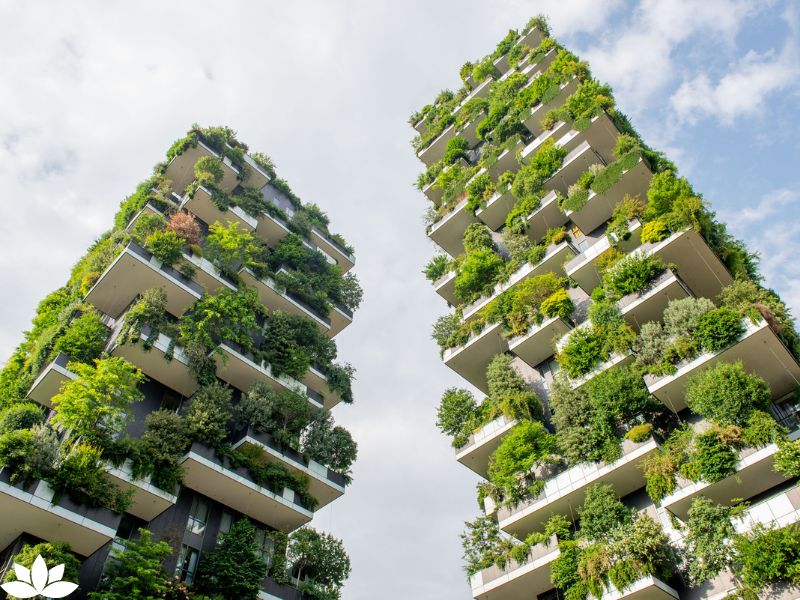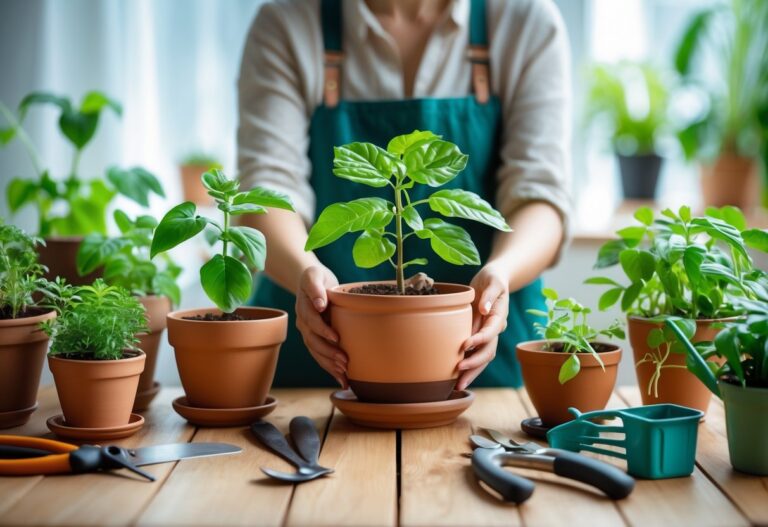Vertical gardening has emerged as a popular solution for those seeking to cultivate plants in limited spaces, particularly in urban environments where outdoor areas may be scarce. This innovative gardening technique involves growing plants upward rather than outward, making optimal use of vertical surfaces. By utilizing walls, fences, or specially designed vertical planters, individuals can create a vibrant garden on their balcony or any other small area.
One of the key benefits of vertical gardening is its ability to significantly enhance urban living. With city dwellers often facing constraints regarding gardening space, creating a garden on your balcony allows for the enjoyment of greenery right at home. This practice not only elevates the aesthetic appeal of a building but also fosters a connection to nature, which can be mentally rejuvenating. The visual impact of cascading plants can contribute to a calming atmosphere amidst the hustle and bustle of city life.
Beyond its visual benefits, vertical gardens also play a crucial role in improving air quality. Plants naturally absorb carbon dioxide and release oxygen, thus creating a healthier living environment. Additionally, they can filter pollutants from the air, which is particularly beneficial in densely populated areas where air pollution is a pressing concern. Furthermore, vertical gardening supports biodiversity by providing habitats for various insects and birds, promoting ecological balance even in urban settings.
In conclusion, vertical gardening stands out as an effective and rewarding method for gardening in small spaces. Whether you have a balcony, a small patio, or limited outdoor areas, this approach not only allows for plant cultivation but also contributes to a more sustainable urban lifestyle. Engaging with this gardening technique can transform your space into a lush oasis of growth and beauty.
Choosing the Right Location

Identifying the optimal location for your vertical garden is crucial to ensure the success of your gardening endeavor on your balcony. The first factor to consider is sunlight exposure. Most plants require a minimum of six hours of direct sunlight daily, while others thrive in partial shade. Observe how sunlight moves across your balcony throughout the day and choose a spot that aligns with the light needs of the plants you wish to grow. An east-facing position could be ideal for sun-loving varieties, while shaded corners may be appropriate for those that prefer indirect light.
Wind protection is another essential aspect to take into account when selecting a location for your vertical garden. Balconies can often expose plants to strong gusts, which may damage tender foliage or disrupt the stability of your structure. Look for areas that provide some natural shielding, such as walls or railings, or consider erecting a windbreak if your balcony is particularly vulnerable. This can greatly improve the health and stability of your plants.
Accessibility for maintenance purposes should not be overlooked. A vertical garden requires regular attention, from watering to pruning. Ensure that the chosen location allows easy access for you to care for your plants without strain. Additionally, proximity to water sources will facilitate your gardening efforts, as having a faucet or hose nearby will streamline the process of hydrating your vertical garden.
Taking the time to thoughtfully evaluate these factors—sunlight, wind protection, accessibility, and water source proximity—will help you identify a suitable location on your balcony for your vertical garden. With the right spot chosen, you can cultivate a flourishing space that enhances your outdoor living experience.
Selecting Suitable Plants for Your Vertical Garden
When creating a vertical garden on your balcony, selecting the right plants is crucial for ensuring a thriving and attractive display. The plants you choose should be well-suited to the conditions of your space, including available sunlight, temperature, and moisture levels. Opting for a diverse selection of herbs, vegetables, and ornamental plants can provide both aesthetic appeal and functional benefits, allowing you to maximize the use of your limited space.
Herbs are an excellent choice for vertical gardens due to their compact size and culinary uses. Consider growing perennial favorites such as basil, parsley, and thyme, which can flourish in a vertical setup. These herbs tend to have low maintenance requirements and can thrive with minimal resources, making them perfect candidates for a garden on your balcony. Furthermore, their seasonal growth patterns allow for continuous harvesting throughout spring and summer, maximizing your gardening efforts.
In addition to herbs, incorporating vegetables into your vertical garden can contribute to a productive space. Climbing varieties, such as peas and pole beans, naturally lend themselves to vertical gardening techniques. Tomatoes, particularly indeterminate types, can also be successfully grown in a vertical arrangement, provided they receive adequate support as they grow. It is essential to choose varieties that match your balcony’s conditions, particularly their sunlight exposure and watering needs.
Lastly, consider ornamental plants to add visual interest to your vertical garden. Varieties such as philodendrons and ivy can create stunning green backdrops while enhancing air quality. Flowering plants like petunias or nasturtiums can also attract pollinators, enriching the ecosystem of your small garden. By carefully selecting plants based on growth patterns and maintenance requirements, you can cultivate a beautiful and sustainable vertical garden that thrives on your balcony.
Essential Vertical Gardening Techniques

Creating a thriving vertical garden on your balcony is an innovative way to maximize limited space while enhancing your gardening experience. Various techniques can be employed to achieve this, with trellises, hanging pots, wall-mounted planters, and stacked planters being among the most effective options.
Trellises are an excellent choice for those looking to grow climbing plants. By installing a trellis against a wall or railing, you can allow vines and other climbing plants to flourish upwards rather than outwards. This not only saves horizontal space but also creates a visually appealing green wall. When choosing a trellis, consider materials such as wood, metal, or plastic, ensuring that it is securely anchored to support the weight of your plants.
Hanging pots offer another practical technique for vertical gardening, allowing plants to cascade gracefully downwards. By utilizing hooks or ceiling-mounted supports, you can suspend pots from above, creating an eye-catching display. This method is particularly suitable for herbs and flowering plants, providing easy access for both maintenance and harvesting. When selecting hanging pots, ensure they have proper drainage to prevent water accumulation.
Wall-mounted planters also provide an efficient use of vertical space. These planters can be attached directly to the wall and are available in various styles and materials, from wood to fabric. They are particularly useful for growing smaller plants, such as succulents and herbs, as they can be arranged in a visually pleasing manner. Make sure to install them securely, and select plants that thrive in the available light conditions.
Finally, stacked planters are ideal for maximizing vertical space while maintaining plant diversity. These modular systems allow you to stack several planters on top of one another, creating a multi-tiered garden. This technique facilitates diverse planting while promoting good air circulation. Choose planters made from porous materials to support plant health and moisture retention.
By employing these essential vertical gardening techniques, you can transform your small outdoor area, creating a lush garden on your balcony while enjoying the benefits of gardening in a compact space.
DIY Vertical Garden Projects

Creating a vertical garden on your balcony is not only a space-saving solution but also an aesthetically pleasing way to incorporate gardening into your daily life. Here, we detail three DIY projects to help you get started: a trellis system, hanging planters, and a stacked planter arrangement.
Trellis System: To construct a simple trellis system, you will need wooden slats (2” x 4”), outdoor weatherproof nails, and a drill. Measure and cut the slats into equal lengths, typically around 6 feet for height. Secure them together in a rectangular shape to create the trellis frame, then attach vertical slats every 12 inches. This structure allows climbing plants, such as beans or peas, to thrive. The estimated cost for materials is around $50, depending on your local supply prices.
Hanging Planters: For hanging planters, utilize vertical space by installing a series of hooks along the railing or walls of your balcony. Purchase several pots or repurpose buckets and attach them to the hooks using sturdy rope or chains. This design not only allows you to display herbs and flowers but also maximizes sunlight exposure for your plants. The cost of this project can range from $30 to $70, based on the number of planters and materials chosen.
Stacked Planter Arrangement: A stacked planter arrangement can be made using wooden crates or commercially available stackable planters. If using wooden crates, secure them one on top of the other, ensuring stability with nails. Fill with soil and choose your favorite plants, such as strawberries or succulents. This arrangement is efficient for space and visually appealing. The total expense for this project is approximately $40 to $100, depending on the planter materials selected.
These DIY projects not only enhance the aesthetics of your small space but also provide a unique opportunity to engage in gardening, allowing you to enjoy fresh herbs and vibrant flowers right from your balcony.
Maintenance Tips for Vertical Gardens

Maintaining a vertical garden requires careful attention to various factors that influence its growth and overall health. One essential aspect is establishing a consistent watering schedule. Vertical gardens can dry out faster than traditional gardens due to their elevated positioning and the nature of their containers. It is advisable to check the moisture level of the soil regularly. A general rule is to water when the top inch of soil feels dry, which may vary from daily to every few days, depending on the weather conditions. Utilizing a drip irrigation system can simplify this process and ensure that plants receive adequate hydration.
Fertilization is another critical component of vertical garden care. Given the limited soil volume in container gardens, nutrients can be depleted quickly. A balanced, water-soluble fertilizer should be used every four to six weeks throughout the growing season. Organic options, such as compost tea or fish emulsion, can also enhance nutrient availability and promote healthy plant growth without the risk of chemical buildup in smaller spaces.
Pest management plays a crucial role in maintaining a thriving vertical garden on your balcony. Regularly inspect your plants for signs of pests such as aphids, spider mites, and whiteflies. Should an infestation occur, consider using insecticidal soap or neem oil, which are effective yet less harmful to beneficial insects. Encouraging natural predators, such as ladybugs, can also help control pest populations.
Seasonal maintenance tasks should not be overlooked. Before the onset of winter, it is important to protect your plants from frost by either bringing them indoors or insulating them. Conversely, spring can be an excellent time for pruning and refreshing the soil to promote new growth. By adhering to these maintenance tips, you can ensure a productive and vibrant vertical garden on your balcony all year round.
Maximizing Space and Efficiency

When aiming to create a thriving garden on your balcony, maximizing space and efficiency becomes paramount. The challenge lies in making the most of limited square footage while ensuring that your vertical garden yields abundant produce or vibrant flowers. One effective strategy to achieve this is through companion planting, which involves grouping plants together that benefit from each other’s growth. For instance, combining herbs with flowering plants not only optimizes space but also promotes healthier plants by deterring pests and enhancing pollination.
Layering plants is another essential technique. By selecting plants of varying heights, you can establish a multi-dimensional vertical garden that not only looks appealing but also enables more sunlight exposure for all varieties. Taller plants such as tomatoes or sunflowers can be positioned at the back, while smaller herbs like basil or thyme can thrive in the foreground. This layered approach ensures that every plant is visible and receives adequate light while utilizing space efficiently. Additionally, utilizing hanging pots or wall-mounted planters can further enhance the available area, creating an organized and visually captivating garden.
Moreover, vertical gardening systems allow for creative use of vertical space. Systems such as shelving units, trellises, or stacked planters can accommodate a wide variety of plants, from leafy greens to flowering options. Abundant choices in planters—such as pocket planters or wall pockets—make it feasible to grow herbs and succulents in surprisingly compact spaces. By leveraging these creative designs and thoughtful organization, balcony gardening can flourish. These strategies not only bolster the efficiency of your gardening endeavor but also contribute to a serene and inviting outdoor environment even in the most constrained settings.
Incorporating Vertical Gardens into Your Lifestyle

Integrating a vertical garden into your daily routine can be both rewarding and fulfilling. Not only does gardening offer physical benefits through the act of maintaining plants, but it also contributes positively to mental well-being. Engaging with nature while tending to your vertical garden can reduce stress levels, promote mindfulness, and enhance overall happiness. The act of nurturing plants has been shown to instill a sense of purpose and accomplishment, making it an ideal hobby for those seeking balance in fast-paced environments.
To fully reap the benefits of gardening, consider involving your family and friends in the process. Gardening can serve as a collaborative activity, fostering deeper connections and creating shared experiences. Assign various tasks, such as planting, watering, and harvesting, to different members of your household. This not only makes the maintenance of your vertical garden more manageable but also creates an opportunity for learning and bonding with each other.
As you cultivate your garden on your balcony, think about ways to share the produce with your community. If your vertical garden yields vegetables, herbs, or flowers, you might consider organizing small giveaways or exchanges with your neighbors. Such actions promote a sense of community while encouraging others to explore gardening themselves. Additionally, sharing your harvest can inspire conversations about sustainable living and gardening practices, further enriching your social interactions.
Incorporating a vertical garden into your lifestyle not only enhances your home environment but also fosters connections with your loved ones and the surrounding community. By being mindful of the joy that gardening can bring, you open yourselves to a world of benefits that extend beyond the physical realm.
Conclusion and Encouragement
Gardening in small spaces, particularly through the innovative approach of a vertical garden on your balcony, offers many advantages that are both practical and rewarding. As we have explored throughout this blog post, vertical gardens not only maximize limited space but also provide a way for urban dwellers to cultivate their green thumbs. By using vertical structures, you can transform your balcony into a lush, productive oasis that enhances your living environment while contributing to your well-being.
Engaging in vertical gardening allows you to grow a variety of plants, from ornamental flowers to edible herbs and vegetables, all within a compact area. This type of gardening fosters creativity and encourages you to utilize every inch of your balcony effectively. Moreover, vertical gardens contribute to better air quality and provide a pleasing aesthetic that elevates the overall ambiance of your home. The satisfaction derived from nurturing your own plants can also enhance your mental health and offer a profound sense of accomplishment.
We encourage you to take the first steps toward creating your own vertical garden. Whether you’re a seasoned gardener or a novice, the journey of gardening on your balcony can be both fun and fulfilling. Start small, choose plants that resonate with your personal taste, and watch your vertical garden flourish. We invite you to share your experiences, successes, and challenges as you embark on this gardening adventure. By doing so, you not only contribute to a vibrant community of garden enthusiasts but also inspire others to enjoy the benefits of gardening in their small spaces. Together, let us celebrate the beauty and potential of vertical gardening.



